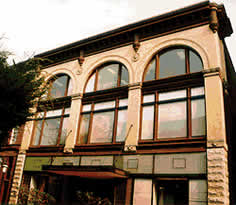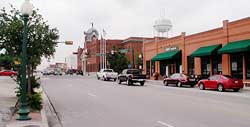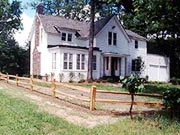
 |
||||||




 |
|
There are four basic factors that influence
the quality of the review process:
![]() The clarity of the design guidelines
The clarity of the design guidelines
![]() The operating
style of the review committee
The operating
style of the review committee
![]() Consistent review
procedures
Consistent review
procedures
![]() Documentation
of decisions and their rationale
Documentation
of decisions and their rationale
Within that framework, here are some excellent tips—presented as a series of steps—for making sure the meeting is clearly presented and that the design critera in the ordinance and local design guidelines that have been adopted are precisely followed.
1. Remember that the purpose of the meeting is to make a decision! Keep this objective paramount. Not only that, the decision should be made in a timely manner, and it should be stated clearly. The commission or review board should enter the review meeting with a willingness to discuss, but always within the context of the design review criteria and guidelines.
2. Focus on the big issues, not on personal biases or petty details. This means that reviewers must distinguish between a design concept that they may dislike personally, but that meets the design criteria and guidelines, and a design that is objectively inappropriate because it clearly violates the design criteria and guidelines.
3. Remember that the ordinance and guidelines that were adopted represent a consensus of residents, professionals, and political leaders, and that the commission's role is to administer them, not to draft new guidelines at every meeting.
4. Listen to the presentation by the applicant and his representatives. This provides the applicant with the opportunity to describe the project objectives and to show the intended design.
 |
|
 |
5. Ask for clarity of presentation content. Withhold design criticisms. First determine that everyone understands what has been presented. Ask questions about what the drawings mean, if necessary. Don't be embarrassed if technical information is not clear. It is your responsibility to be certain that you understand what has been presented.
6. Check to see that documentation for the proposal is complete. If important drawings, models, or photographs are missing that are essential for the commission to make a determination, cut the review short before getting into design criticism. Reviewing an incomplete application is a waste of time for everyone. It may also be a disservice to an applicant if a proposal is denied, simply because it is misunderstood.
7. If the documentation is complete, critique the proposal following the design criteria and guidelines. Use a checklist to see that you covered all the items, and ask for public comments as well. You should allow open discussion among the commission, applicant, and public, but keep it on track and avoid tangential issues that may be emotionally charged, but do not have direct bearing on the appropriateness of the design in terms of the criteria and guidelines.
8. When the discussions seem to be over, ask these questions of yourselves.First: "Have the criteria and guidelines been sufficiently met to merit an approval? You have two choices for an answer: "Yes" or "No." Second: "Which criteria and guidelines give you the basis for making this decision?" An approval or disapproval should be based on specific criteria in the ordinance, and you should be able to identify the critical ones. If you can answer these questions, you are ready for a vote!
9. Once you have voted, summarize the outcome clearly. Remember, you are not finished until you have a summary! Do not let the applicant leave without understanding what you have decided-approval, denial, a conditional approval, re-submission of a new design, etc.
10. Finally, thank the applicant for participating in the process. A successful design review meeting means that you have treated the applicant fairly by basing your decision—either way—squarely on the ordinance's design criteria, and the design guidelines written and adopted by your community.
---------------------------------
Adapted from Making Judgements in the Review Process: A Guide for the Design Review Committee by Noré V. Winter, 1986.